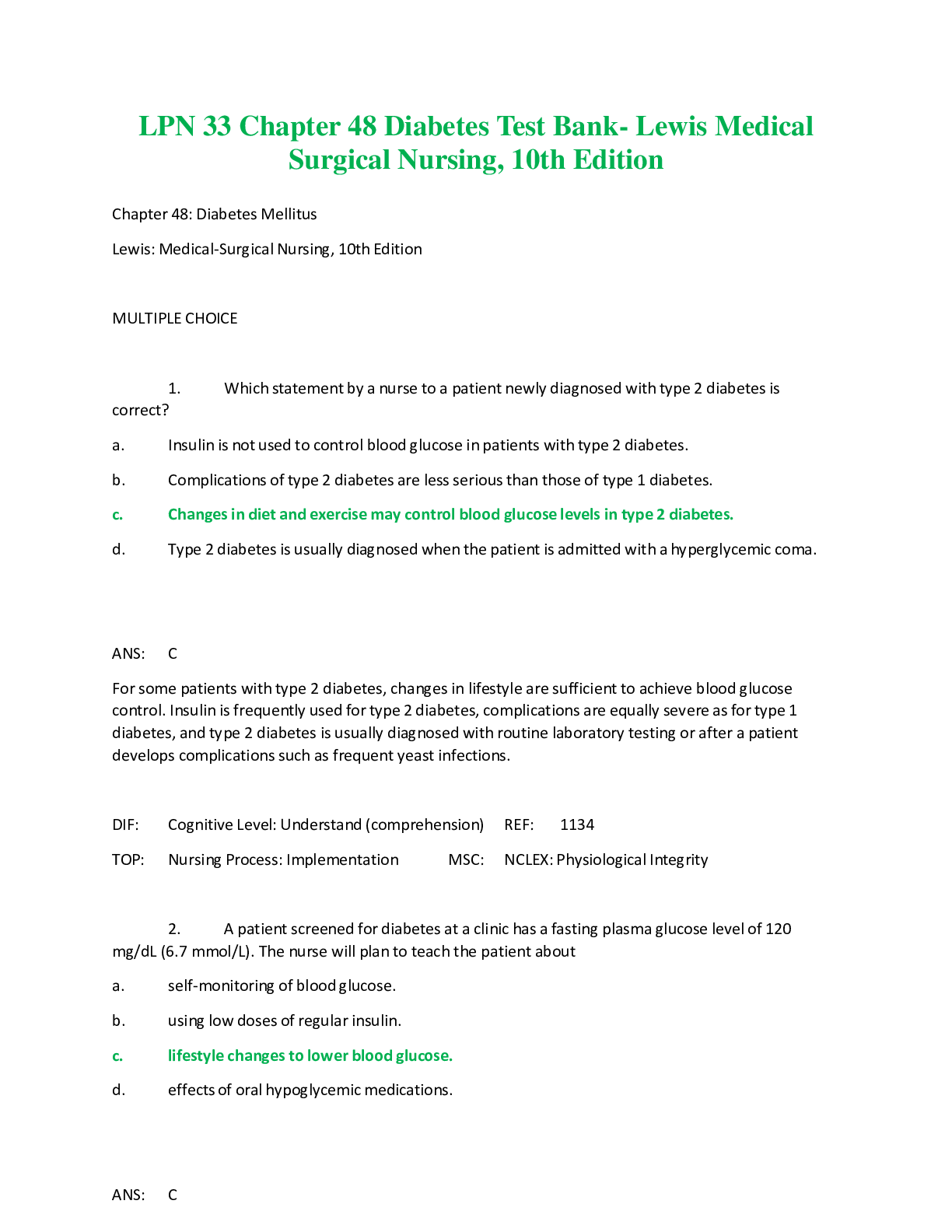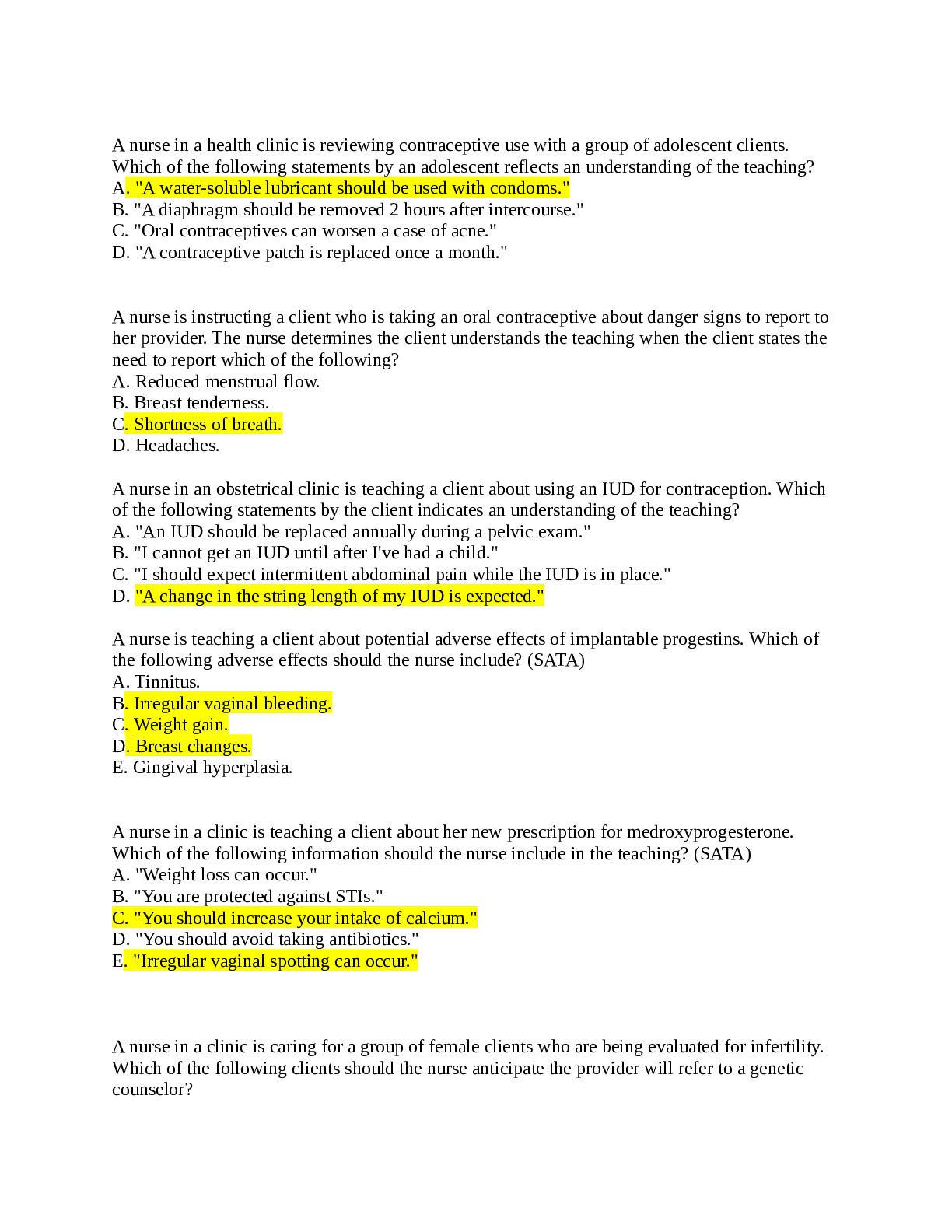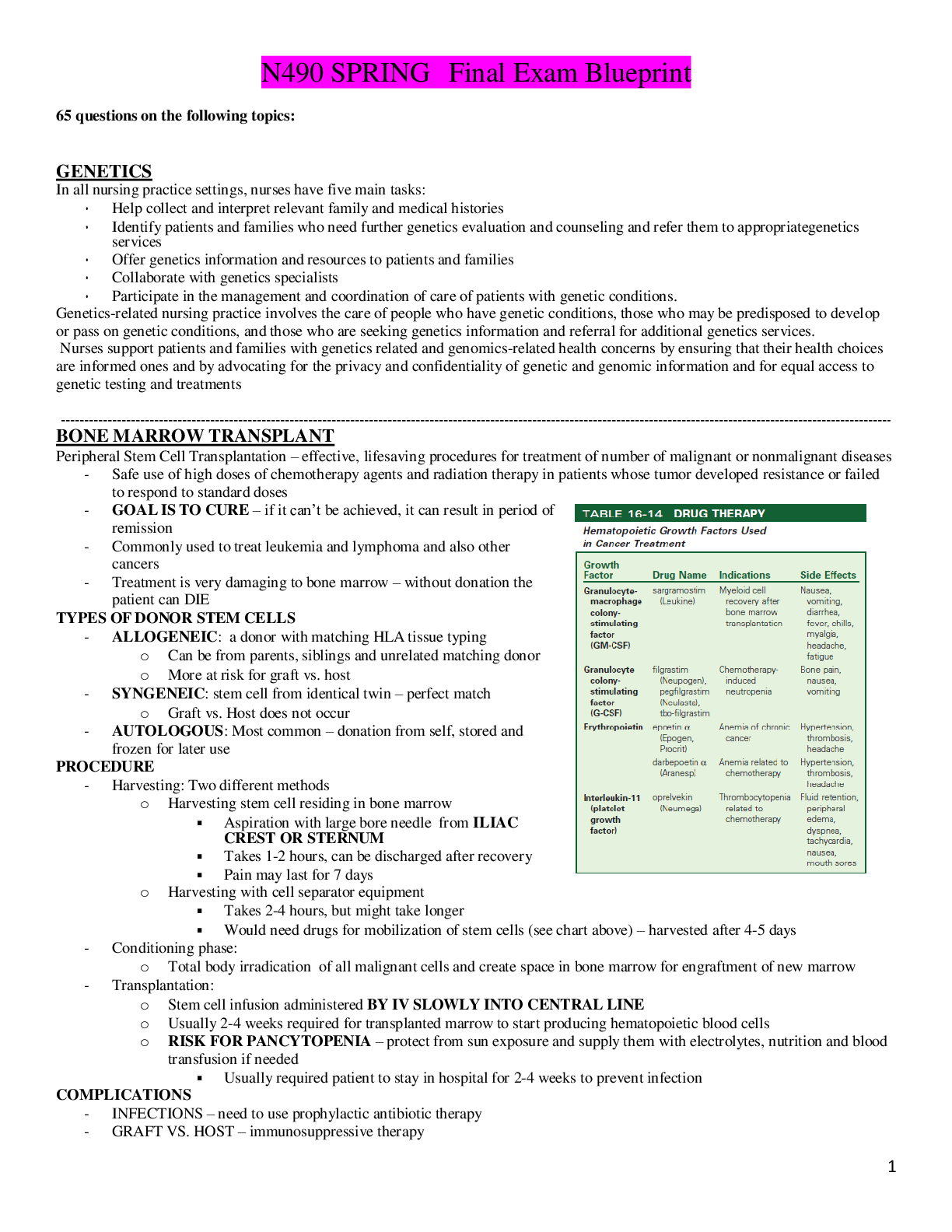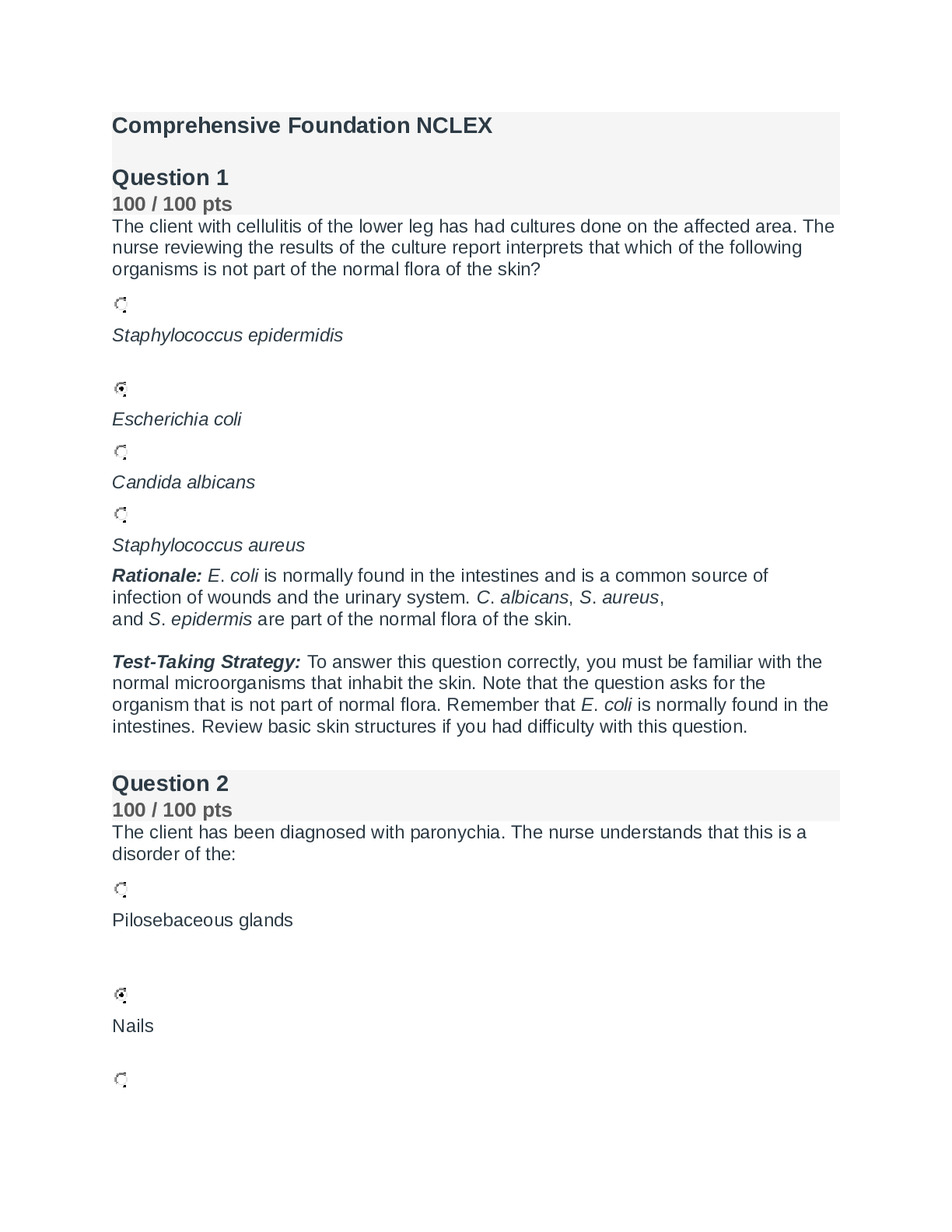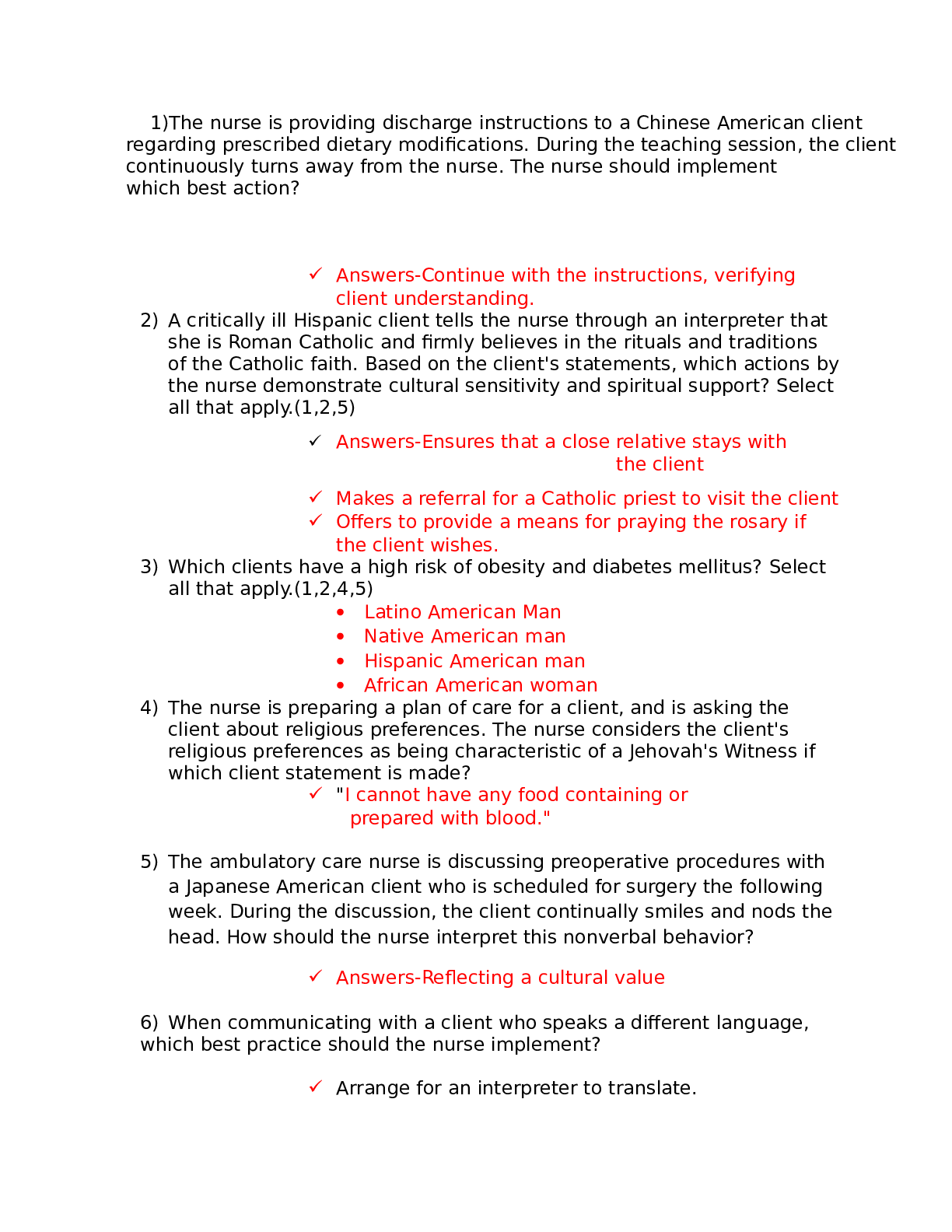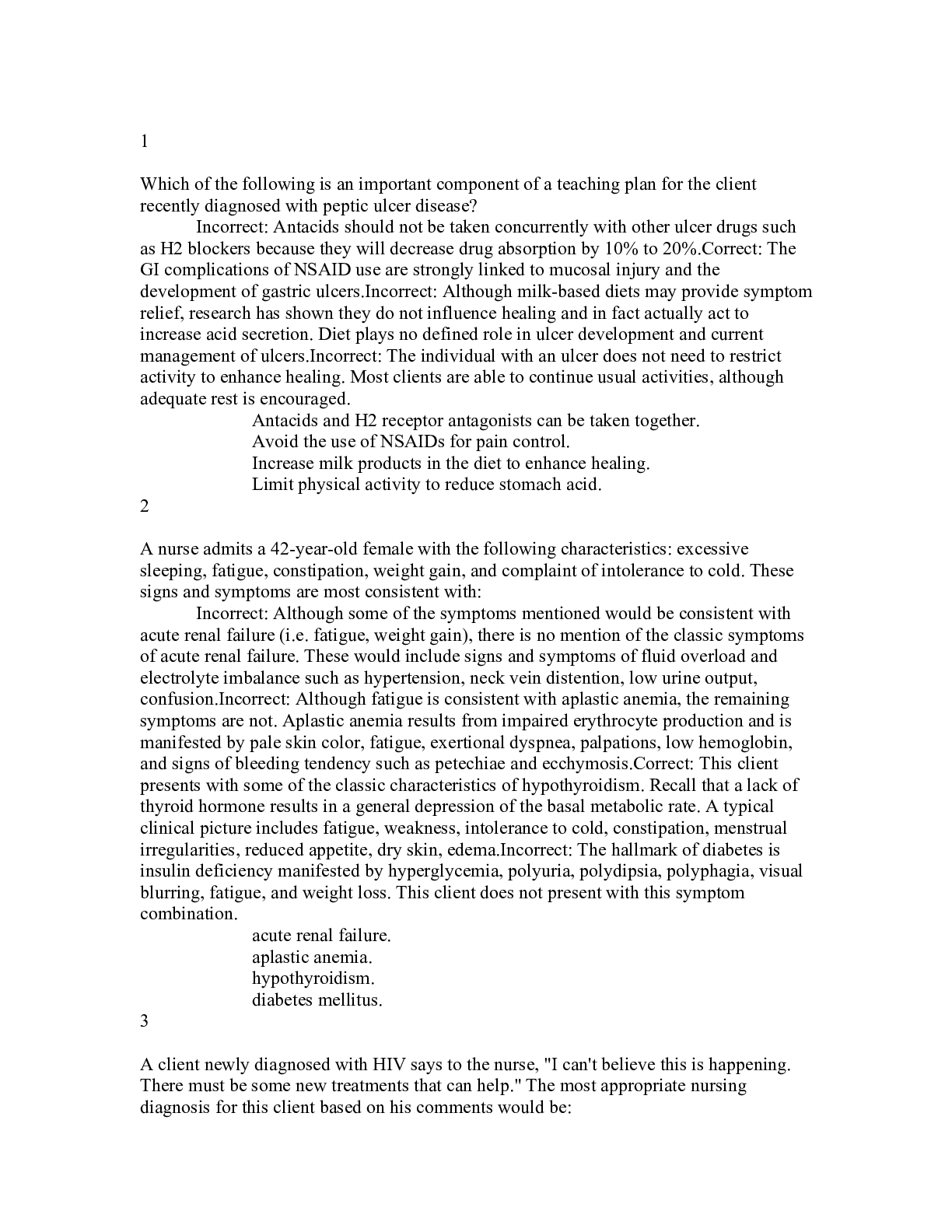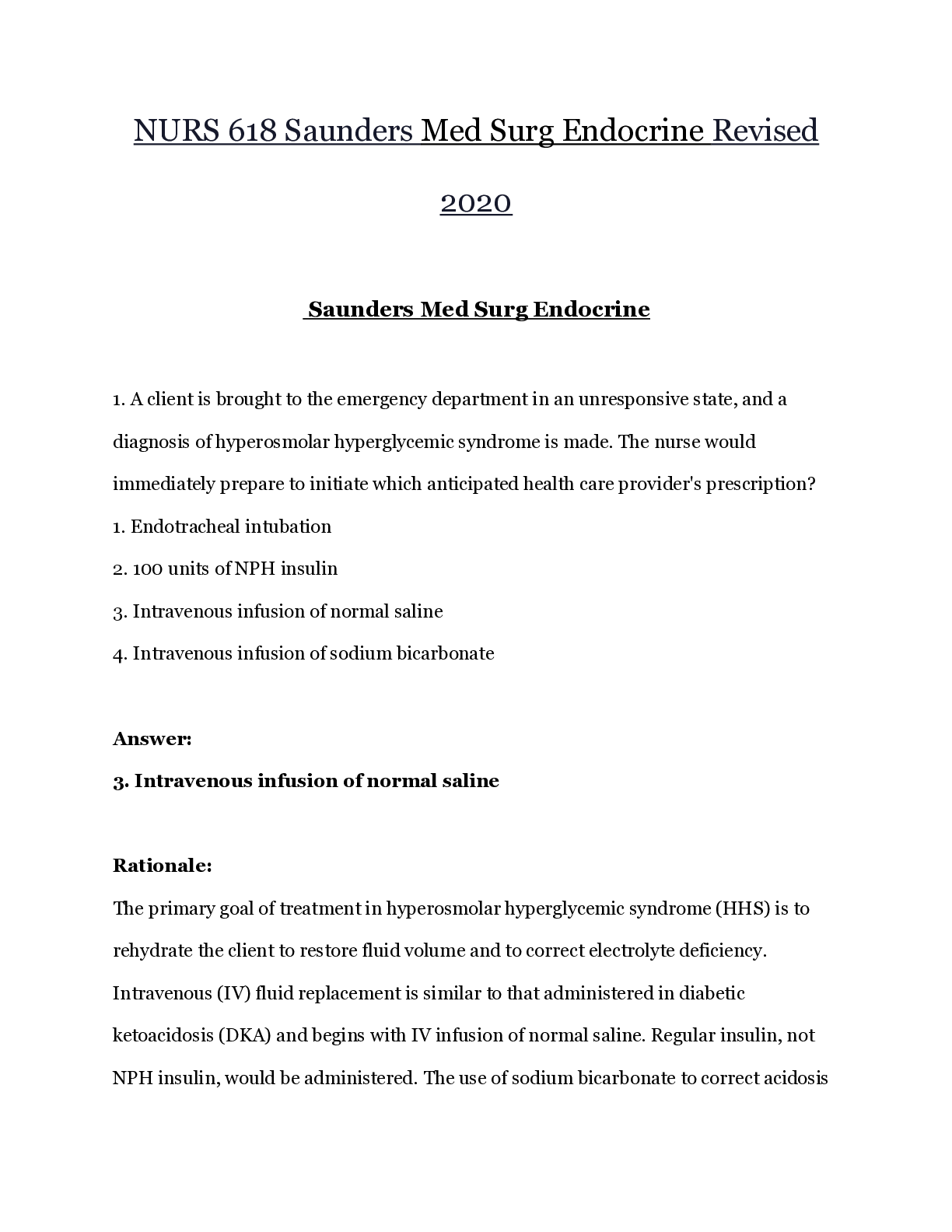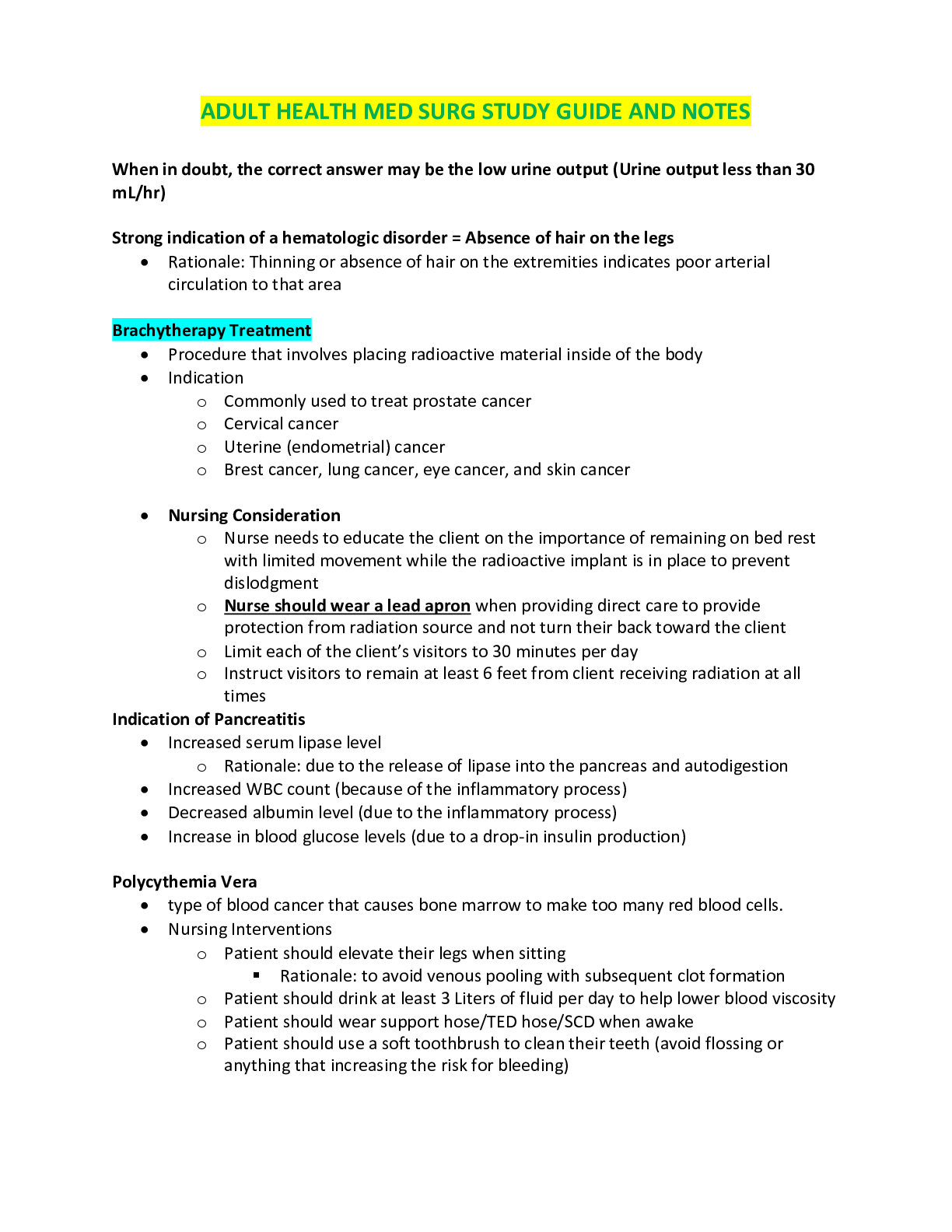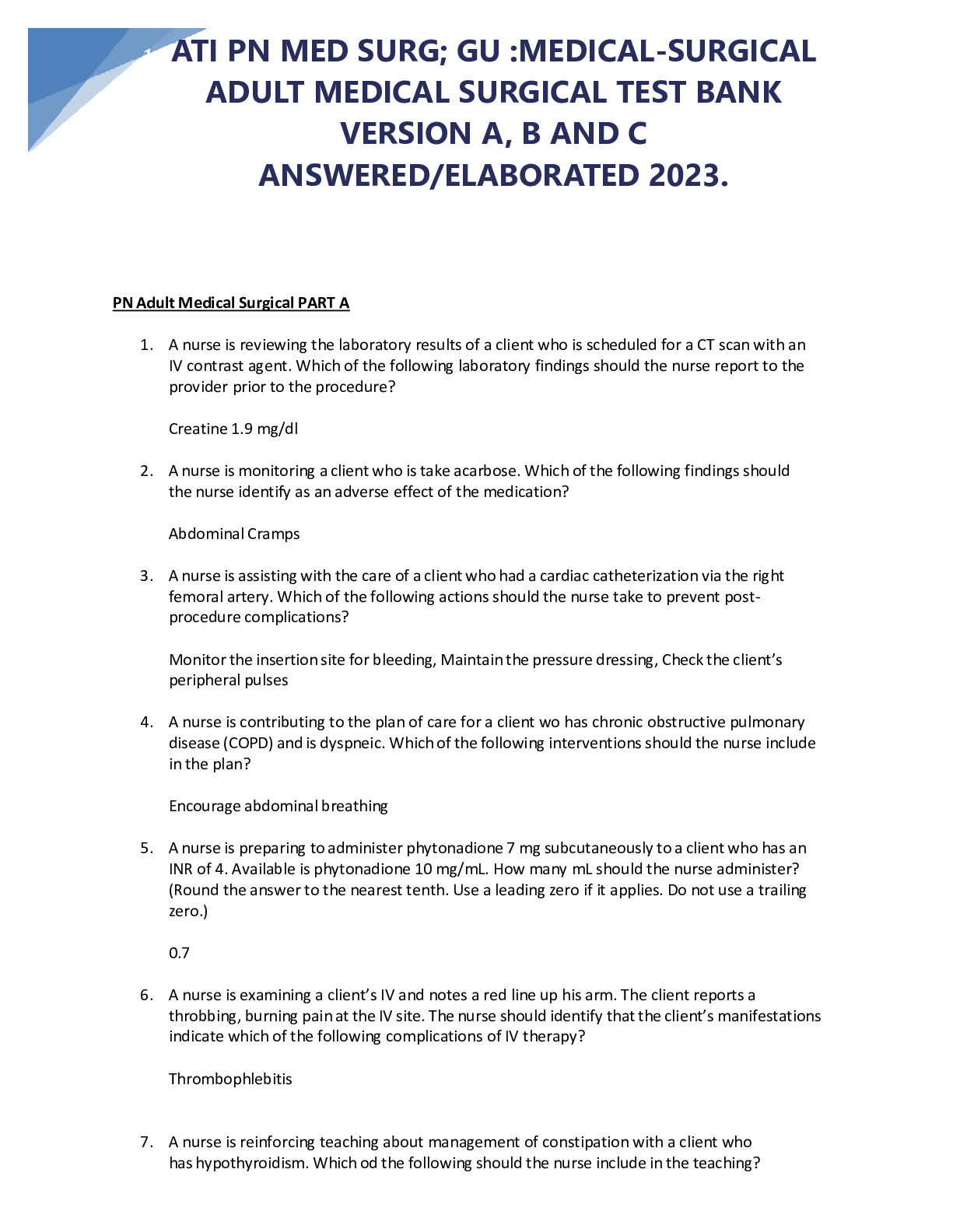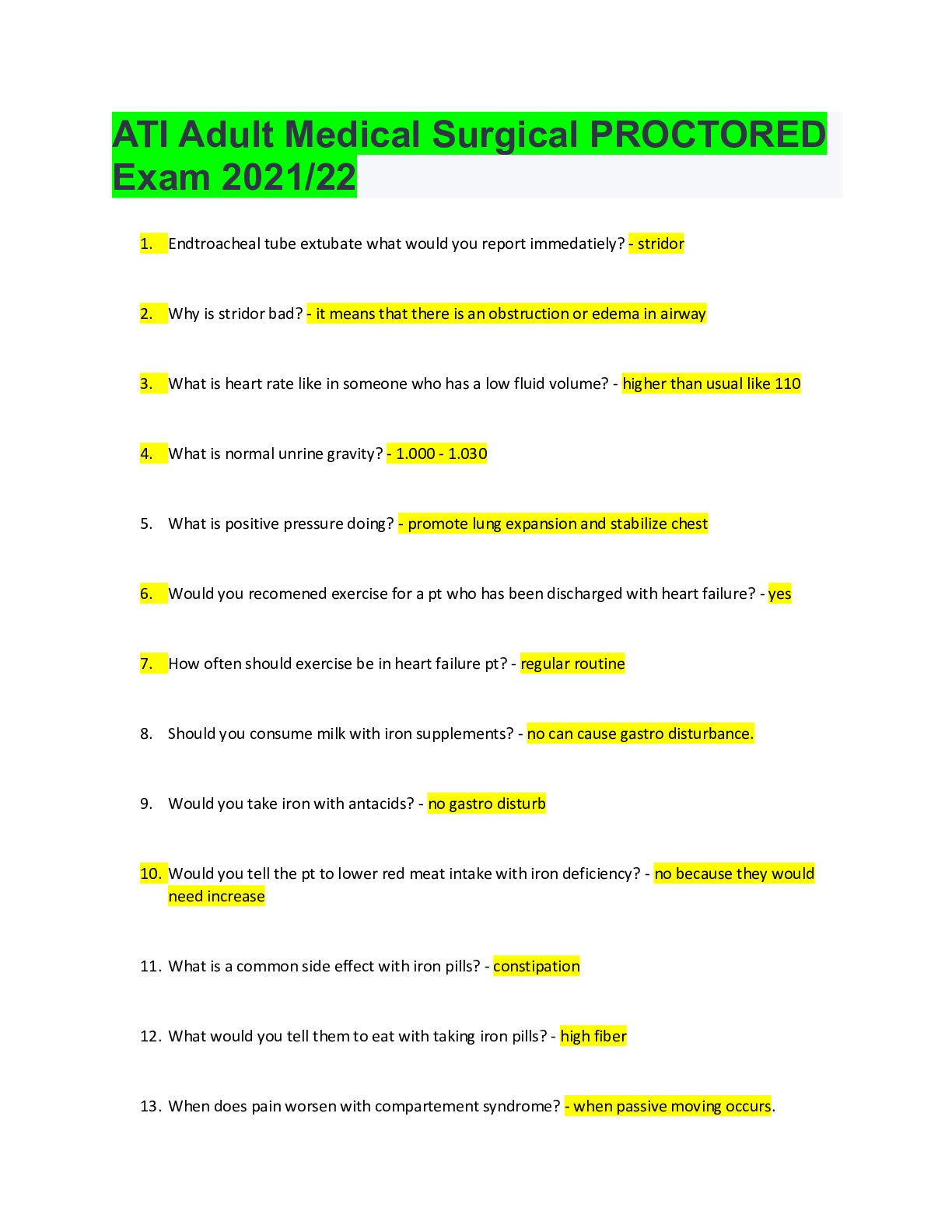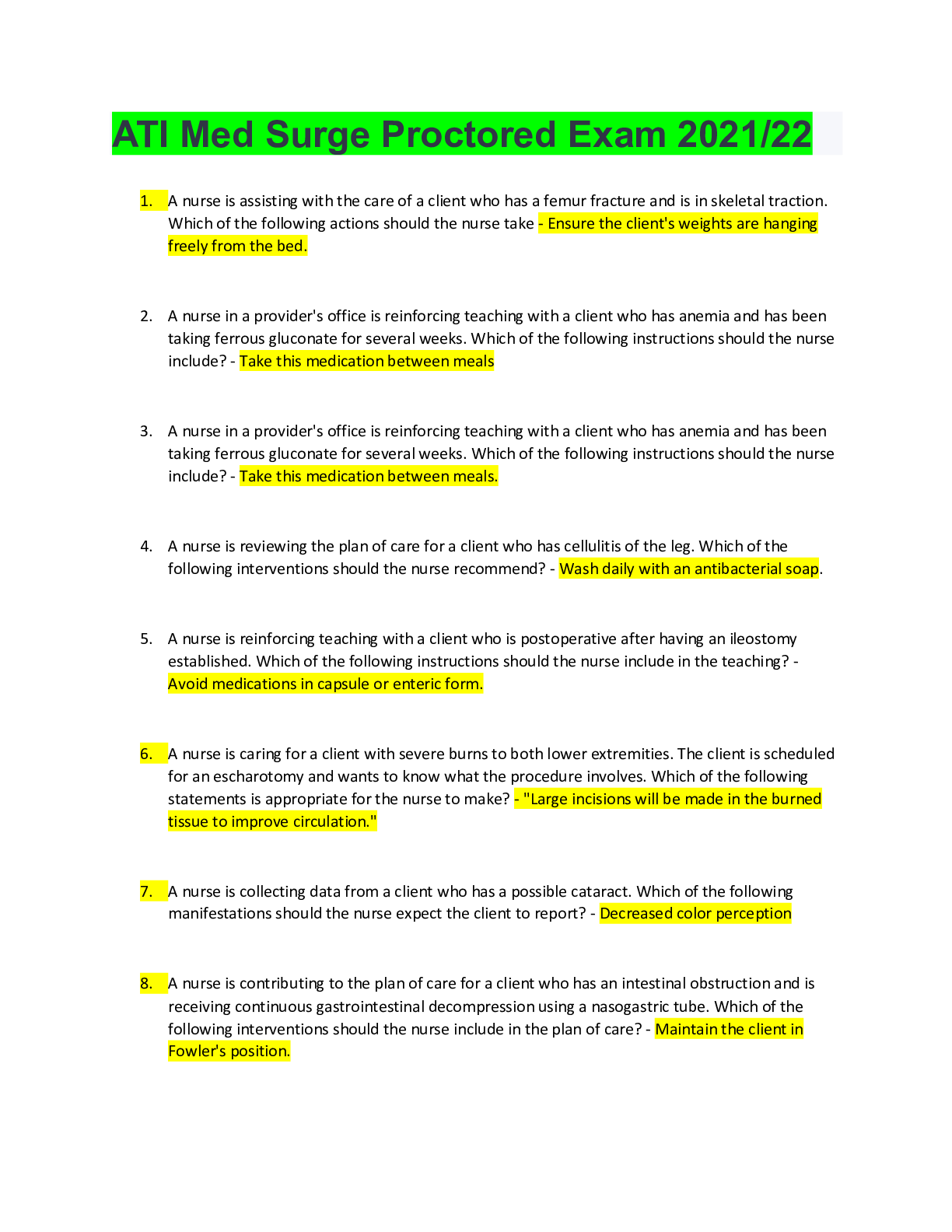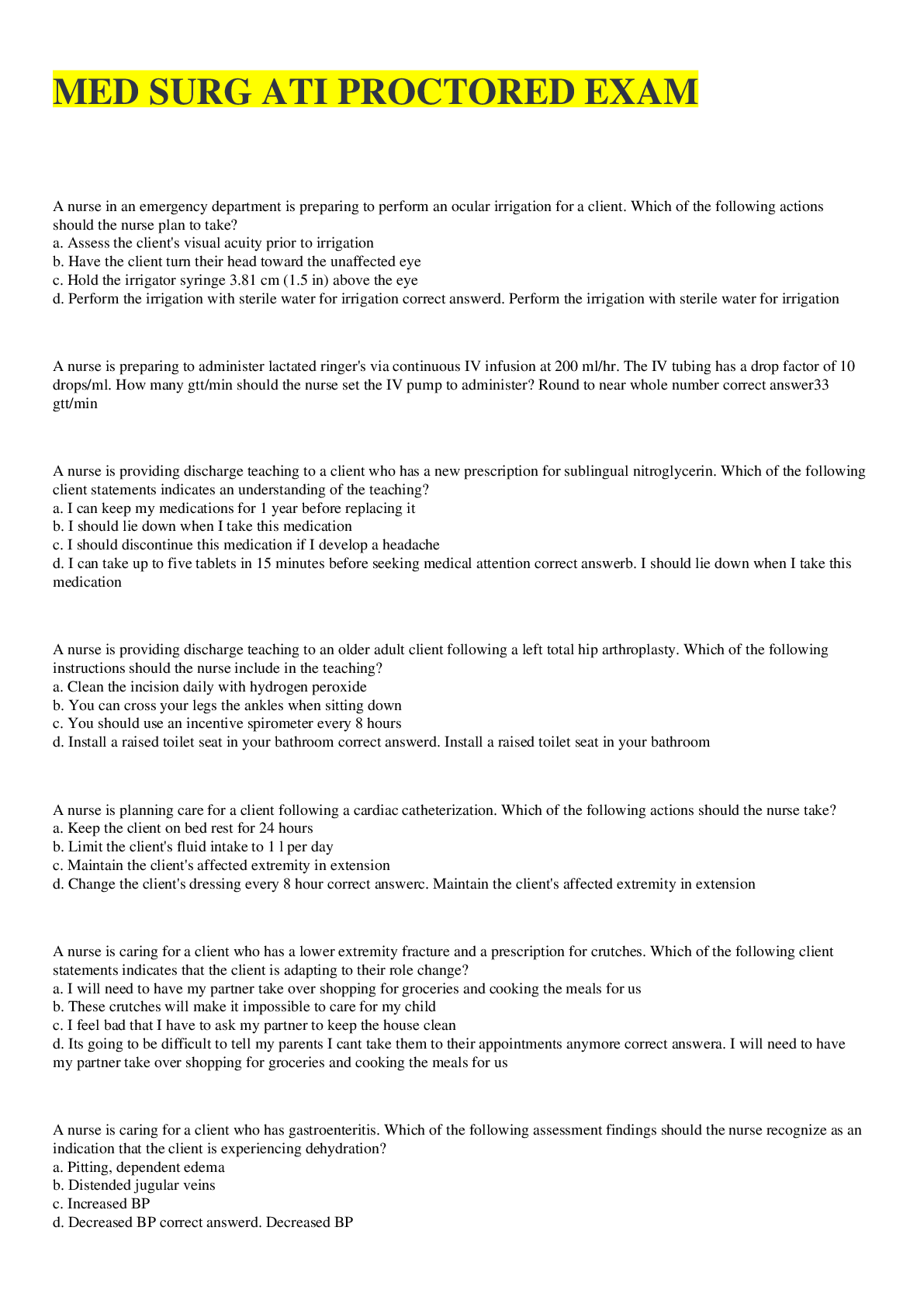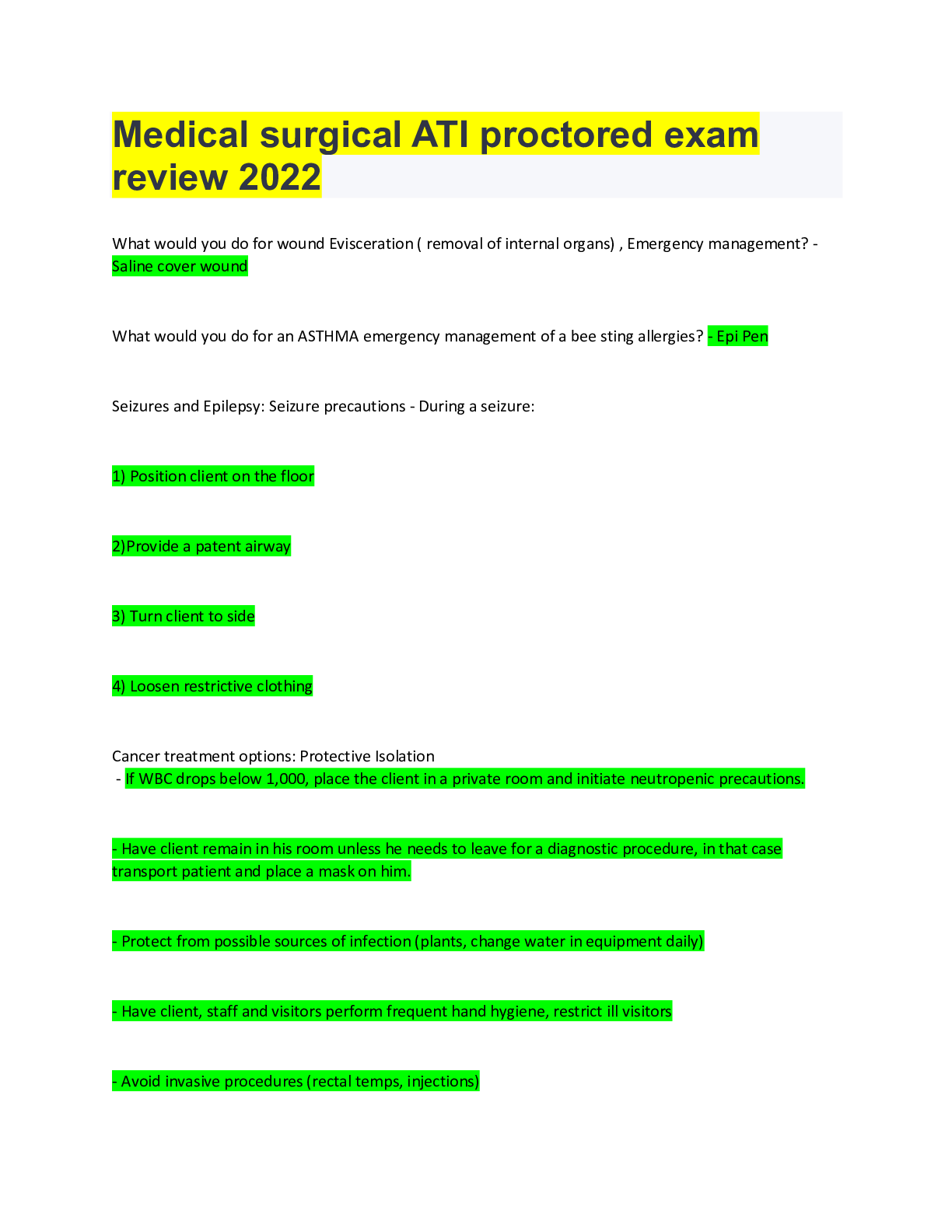*NURSING > MED-SURG EXAM > NURSING Med Surg 2 Hemodynamic NCLEX Questions and Answers / (Latest, 2021/2022) (Received Score 10 (All)
NURSING Med Surg 2 Hemodynamic NCLEX Questions and Answers / (Latest, 2021/2022) (Received Score 100%)
Document Content and Description Below
Hemodynamic NCLEX Questions: 1. A client in the ICU has an abnormal pulmonary artery wedge pressure. What should the nurse do? Retake the measurement and Look at this finding in relation to other mea... surements. 2. The nurse has just measured a client's cardiac output using the thermodilution method. The findings show a notched, uneven curve. What should the nurse do with these results? Repeat the measurement. A small curve indicates a high CO, a large curve indicates a low CO, and a notched or uneven curve indicates a poor injection technique and should be repeated. 3. A client is having a continuous cardiac output pulmonary artery catheter placed. Which of the following would be indicated for this client? The cardiac output measurements will change according to the measuring device's findings and the findings from this catheter are consistently accurate. 4. The nurse is planning the care for a client with an elevated right atrial pressure. Which of the following should be included in this plan of care? Administer vasodilating medications as prescribed and Monitor intake and output. Care is directed toward optimizing preload by reducing volume. Overall goals are to decrease venous return to the right heart, increase contractility, and decrease the workload of the heart. Preload can be reduced by fluid and sodium restrictions and the administration of diuretics or vasodilating medications. Nursing care should include intake and output, daily weights, dietary consult for any restrictions, and medication teaching to enhance adherence. 5. During the review of a client's hemodynamic measurements the nurse sees a right ventricular waveform. What should the nurse do for this client? Notify the physician for repositioning. 6. While monitoring a client's pulmonary artery pressure the nurse sees a distinct notch in the waveform. What should the nurse do about this finding? Nothing. This is a normal finding. The pulmonary artery waveform has a characteristic pattern consisting of a steep upstroke and a downstroke that is distinguished by a dicrotic notch formed by the closure of the pulmonic valve. 7. The nurse is planning the care of a client with an elevated pulmonary artery systolic pressure. What should be included in this plan of care? Administer diuretics as prescribed and Monitor intake and output. Interventions are determined by the cause. Reduce preload by administering diuretcs and imposing fluid and sodium restrictions. The use of inotropic medications might be prescribed. An intraaortic balloon pump might be indicated. Nursing care should also include measuring intake and output and daily weights. Activities should be planned around rest periods. 8. A client in the ICU has an elevated pulmonary artery wedge pressure. What should be included in this client's plan of care? Monitor intake and output. Interventions are directed toward optimizing preload by administering diuretics, vasodilators, nitrates, ACE inhibitors, and inotropics. Sodium and fluid restrictions are also indicated. Also, intake and output and daily weights should be measured. Activities should be limited and paced to the client's tolerance level. 9. A client has a systemic arterial blood pressure monitor. Which of the following should be included in the plan of care for this client? Monitor the site for infection. Secure the pressure tubing to prevent dislodgement and possible exsanguinations. Monitor circulation distal to the insertion site. Monitor the site for infection. Arterial line blood pressures compared with noninvasive blood pressures do not always agree. 10. Explain how a pulmonary artery catheter will help the nurses and physicians plan interventions to enhance cardiac functioning. Define CO. What is the equation for determining CO? What measurement references CO to size? Elevation of which of the hemodynamic readings would indicate left-sided failure with no right-sided pathology? Briefly describe the function of the arterial line. EKG NCLEX Questions: 1. A client in the ICU is prescribed Calan (verapamil), a calcium channel blocker. The nurse knows that this medication will affect cardiac membrane permeability, specifically during: Phase 2. During the second phase, calcium moves into the cell or the calcium channels open. A calcium channel blocker will reduce this influx of calcium. 2. A client in the ICU is on continuous cardiac monitoring. Which of the following should be included in the plan of care for this client? Explain to the client that there is a low risk of shock from the electrodes and Change the location of electrodes after daily bathing. Nursing actions include preparing the client's chest wall for electrode placement, the need to rotate electrode sites, setting alarms, documenting the ECG in the medical record, client teaching about the monitor, findings, and alarms. 3. A client in the ICU has fluid volume overload and hypokalemia. Which of the following might be seen on this client's ECG? Lengthened QT interval and Presence of a U wave. With hypokalemia, the PR interval may be longer, the T wave may be flat, the QT interval may lengthen, an extra wave may follow the T wave (U wave), and PVCs may occur. Fluid volume overload may result in ventricular enlargement and decreased contractility leading to premature beats, cardiac conduction blocks, and an abnormal heart rate 4. A client in the ICU has been diagnosed with superventricular tachycardia. Which of the following might be done to help this client? Prepare to administer adenosine and Coach the client in the Valsalva maneuver. Treatment strategies include adenosine, beta-blocking agents, calcium channel blockers, digitalis, cardioversion, and overdrive pacing. If the client is asymptomatic, drug therapy is initiated to slow the rate. It may also be treated with the Valsalva maneuver. 5. A client in the ICU is demonstrating PVCs on his ECG rhythm. Which of the following should the nurse do to assist this client? Study the client's underlying cardiac rhythm. Determine factors that contribute to the occurrence of PVCs. Ischemia is a cause of PVCs. Hypoxia, acidosis, hypokalemia, and digitalis toxicity are all associated with PVCs. Not all PVCs are treated. Lidocaine may be administered. Amiodarone or proncainamide may be administered if lidocaine doesn't work. The underlying cardiac rhythm needs to be assessed along with the type of PVCs. The timing and pattern are also assessed. 6. A client in the ICU continues to demonstrate PVCs on his ECG rhythm. The nurse knows the medications commonly used to treat this type of dysrhythmia include: Treatment of PVCs includes the administration of class IA, IB, and IC medications. 7. A client is going to undergo cardioversion. Which of the following should be included in the care of this client? Provide a sedative prior to the procedure. The nurse assists with cardioversion by obtaining an ECG strip prior to, during, and after the procedure. Informed consent is obtained and IV access is confirmed before the procedure. Provide a sedative to the client prior to the procedure to minimize discomfort. Report any electrolyte imbalances to the physician. Remove all jewelry, oxygen, or other metallic objects from the client. Place conductive pads on the client. Assess after the procedure for emboli, respiratory depression, skin burns, or dysrhythmias. 8. The nurse is preparing to instruct a client about the implantable cardioverter/defibrillator. Which of the following should be included in this instruction? Instruct to obtain a medic alert bracelet. Client education is extensive and is to include the difference between a heart attack and cardiac arrest. Also, the client should keep a log and be advised of when to contact the physician. Clients with this device need to avoid high magnetic fields because this might activate the device. Cell phones can interfere with the operation of all defibrillators if held closer than 6 inches from the pulse generator. Instruct to keep a copy of their ECG, device model number, and obtain a medic alert bracelet. 9. Six steps of evaluating an ECG tracing- Heart rate, R-R interval, P wave, P-R interval, P waves followed by a QRS complex and QRS complex analysis. Altered Myocardial Tissue Perfusion NCLEX Questions 1. Client in the ICU is experiencing a sudden drop in blood pressure, affecting his cardiac output. Upon closer inspection, the nurse finds that due to nurse error, this client has lost a significant amount of blood and hasn't received his prescribed intravenous fluids. What should the nurse do with this information? Contact the physician and complete an occurrence report. 2. A client in the ICU is combative and has been attempting to pull out his endotracheal tube and pulmonary catheter. What should the nurse do? Discuss the use of restraints with the physician and Review the hospital policy on the use of restraints in the ICU. 3. A client is in the ICU diagnosed with a fluid volume deficit. Which of the following should be included in this client's plan of care? Independent nursing actions include monitoring intake and output, assisting with pain control and anxiety, monitoring vital signs continuously, evaluating the effects of fluids and medication therapy, keeping the family informed about the plan of care, and assessing and reporting any changes in the client's condition. 4. A client is being treated for a decrease in cardiac output. How will the nurse know if the treatment is effective? Client's urine output is improving. and Client’s measure of cardiac output is improved. 5. A client being transferred from the ICU after a life-threatening cardiac event tells the nurse, "I can't thank you enough for saving my life. I have so much to do to improve my health!" This client is demonstrating: A change in focus to health and wellness. This client is more than likely euphoric that she is alive and may want to stay that way. This client is prepared to learn much to prevent any further deterioration of her health and ways to improve her health. 6. A client admitted to the ICU with fluid volume overload, asks the nurse if she has to have life-support measures because she doesn't want "to be dependent upon tubes." This client is asking for information about: Advance directives. 7. A client is in the ICU in fluid volume excess. Which of the following would be considered treatment goals for this client? Monitor inotropic medication therapy. And Monitor vasodilator therapy. Treatment goals are focused on decreasing the workload of the heart while maintaining perfusion and normal body functioning. 8. A client in the ICU with fluid volume overload is visiting with family members who've picked up a "hamburger with the works" for the client. What should the nurse say to the client and the family? Maybe we can spend a few minutes talking about the foods permitted on your eating plan. Clients in fluid volume overload might be placed on a sodium-restricted diet. 9. The nurse is concerned about a client who is demonstrating signs of worsening fluid volume overload. What is causing the nurse to come to this conclusion? Increasing dyspnea. Evaluate ABGs for metabolic or respiratory acidosis, assess for dyspnea, any abnormal breath sounds, any extra heart sounds, jugular vein distention, ascites, weight gain, or abnormal electrolyte levels. 10. The nurse in the coronary care ICU is planning to draw blood to determine if a client has sustained a myocardial infarction. List the laboratory tests that would provide this information for the nurse CPK-MB and Troponin ABG Interpretation Biggies for acidosis - hyperkalemia and hypotension placing patient at risk for dysrhythmias and dizziness Biggies for alkalosis - hypokalemia, hypocalcemia, tachycardia: dysrhythmias, PVCs, tetany, tremors 1. Respiratory acidosis: problem: hypoventilation is causing CO2 retention causes: anything that causes hypoventilation of affects ventilation, diffusion, or perfusion: pneumonia, atelectasis, COPD, sedative overdose, respiratory muscle weakness (GBS), obesity labs: low pH and high CO2 s/s: "depression session": confused, dizzy, hyperkalemic (risk for v-fib and dysrhytmias), hypotension, hypoventilation treatment: correct hypoventilation, O2 100% NON-rebreather mask, bronchodilators, expectorants, monitor lytes, fluids 2. Respiratory alkalosis: Problem: hyperventilation is causing excessive loss of CO2 Causes: any hypermetabolic state or hyperventilatory state that stimulates respiratory center: infection, fever, anxiety, fear, pain, PE Labs: high pH and low CO2 S/s: anxious, confused, hypokalemic (risk for PVCs), tachycardic, hypocalcemic (tetany and tremors), hyperventilation Treatment: paper bag, rebreather mask, calm patient down 3. Metabolic acidosis: Problem: body is losing HCO3 or has too much acid buildup causes: severe diarrhea (loses HCO3), lactic acidosis, DKA, renal disease (cannot keep HCO3), starvation, GO fistulas, shock labs: low pH low HCO3 s/s: drowsy, confused, hyperkalemia, hypotension, Kussmaul's to compensate treatment: IV sodium HCO3, dialysis, rehydration, anti-diarrheals, treat hyperkalemia 4. Metabolic alkalosis Problem: body has too much HCO3 causes: loss of acids, ingestion of HCO3: severe vomiting, prolonged NGT suctioning, diuretics, excess mineralocorticosteroids labs: high pH high HCO3 s/s: irritable, tachycardia, hypokalemia, hypocalcemia (tetany, tremors), hypoventilation treatment: K-sparing diuretics, fluids to rehydrate, anti-emetics, IVFs likee 1/2 D5W, K protocol, Is and Os [Show More]
Last updated: 1 year ago
Preview 1 out of 5 pages
 (1).png)
Reviews( 0 )
Document information
Connected school, study & course
About the document
Uploaded On
May 31, 2021
Number of pages
5
Written in
Additional information
This document has been written for:
Uploaded
May 31, 2021
Downloads
0
Views
56

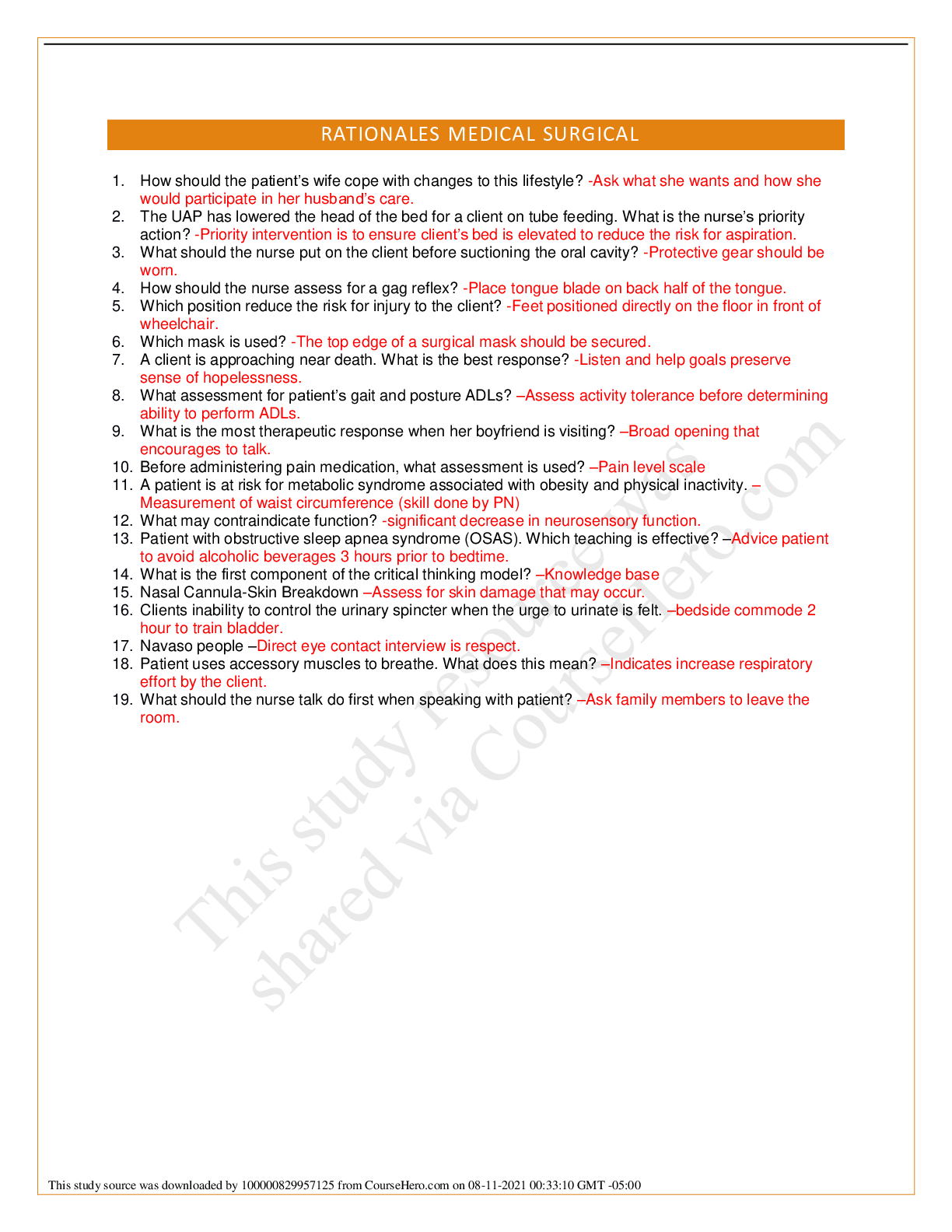
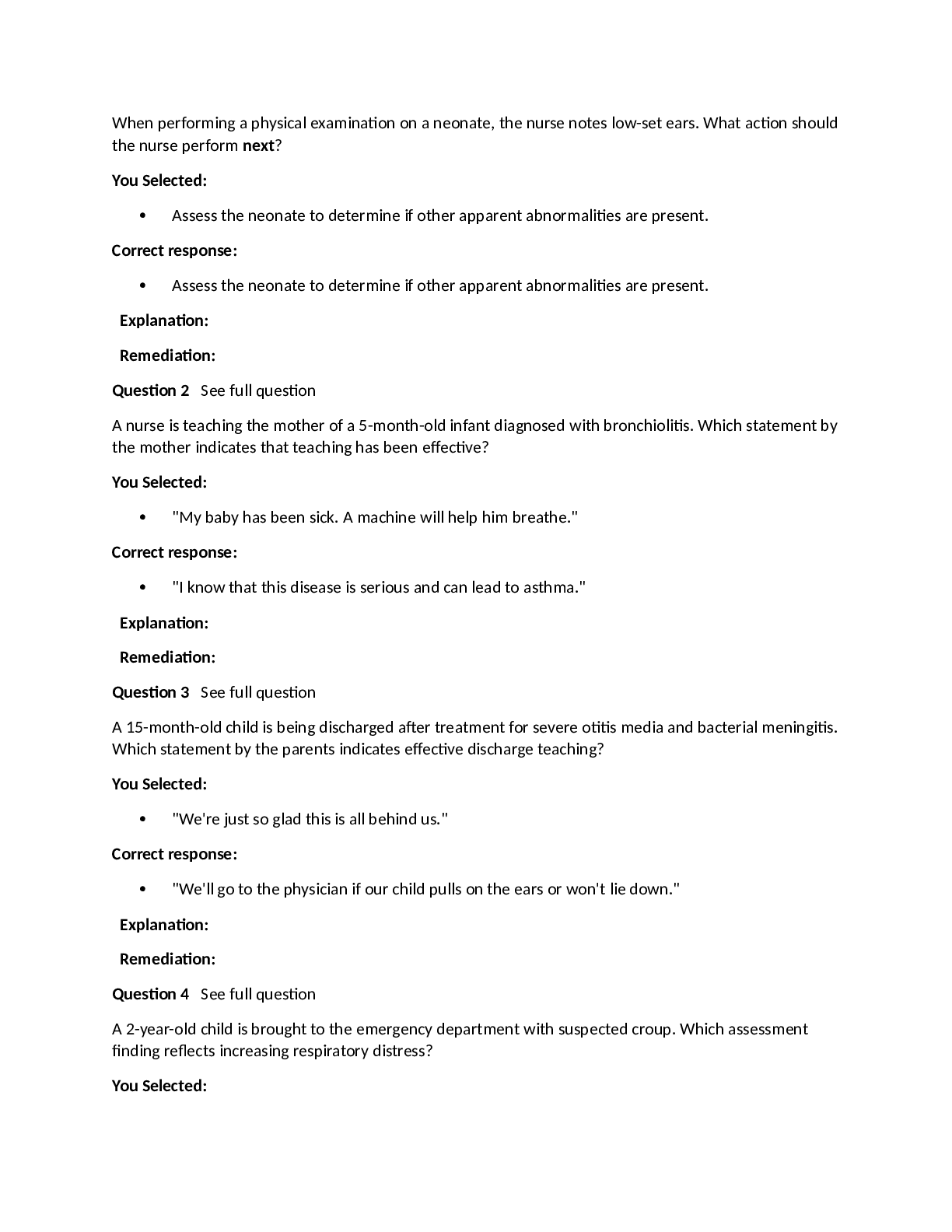
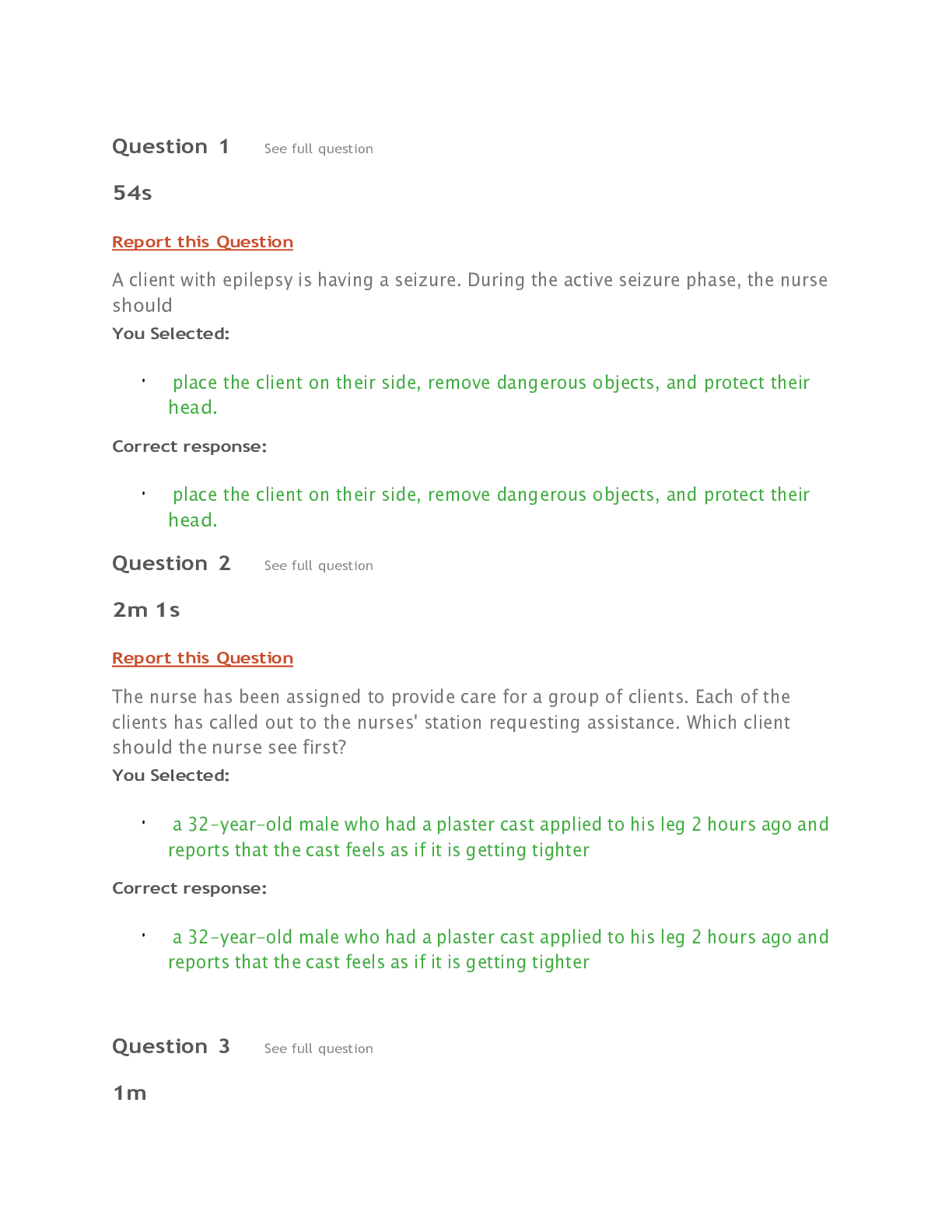
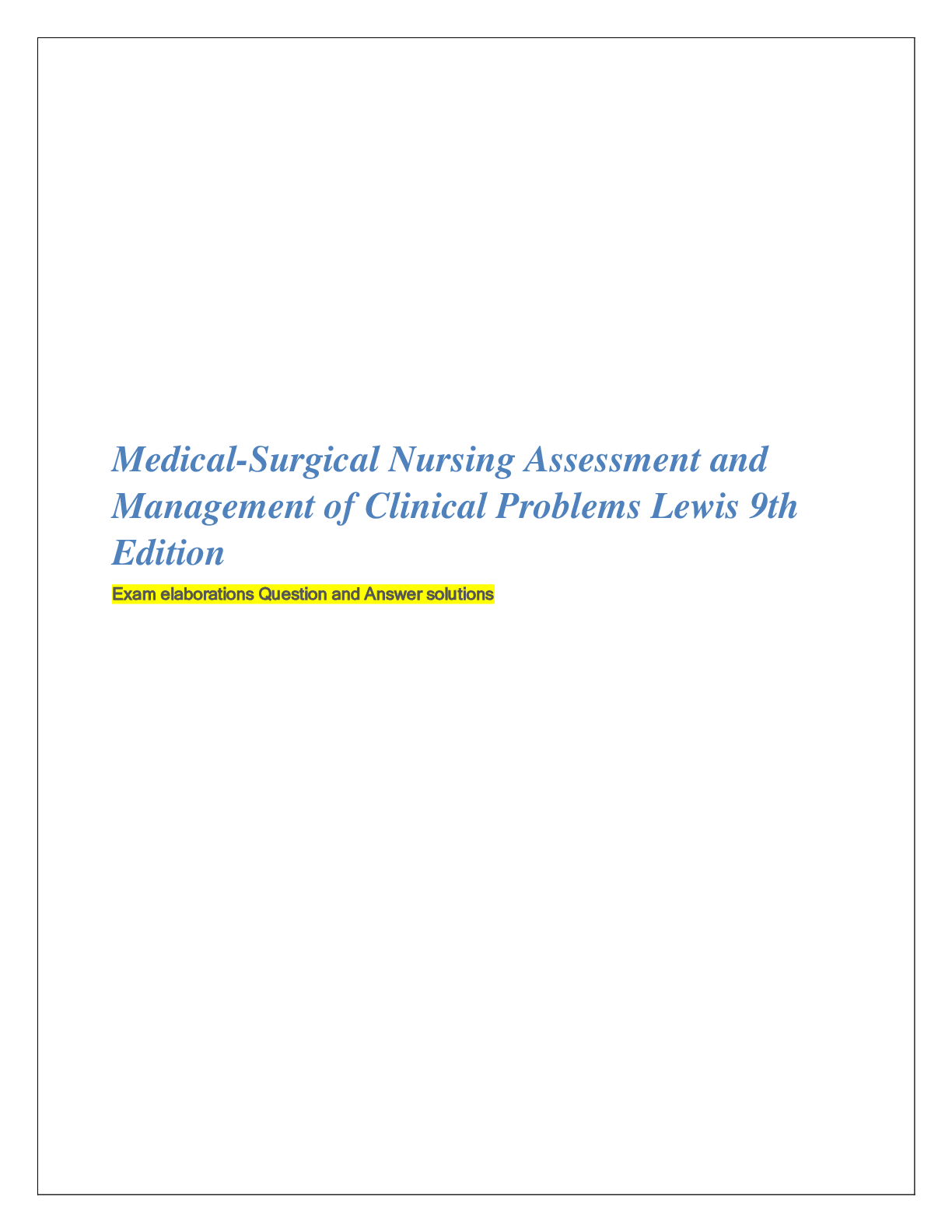

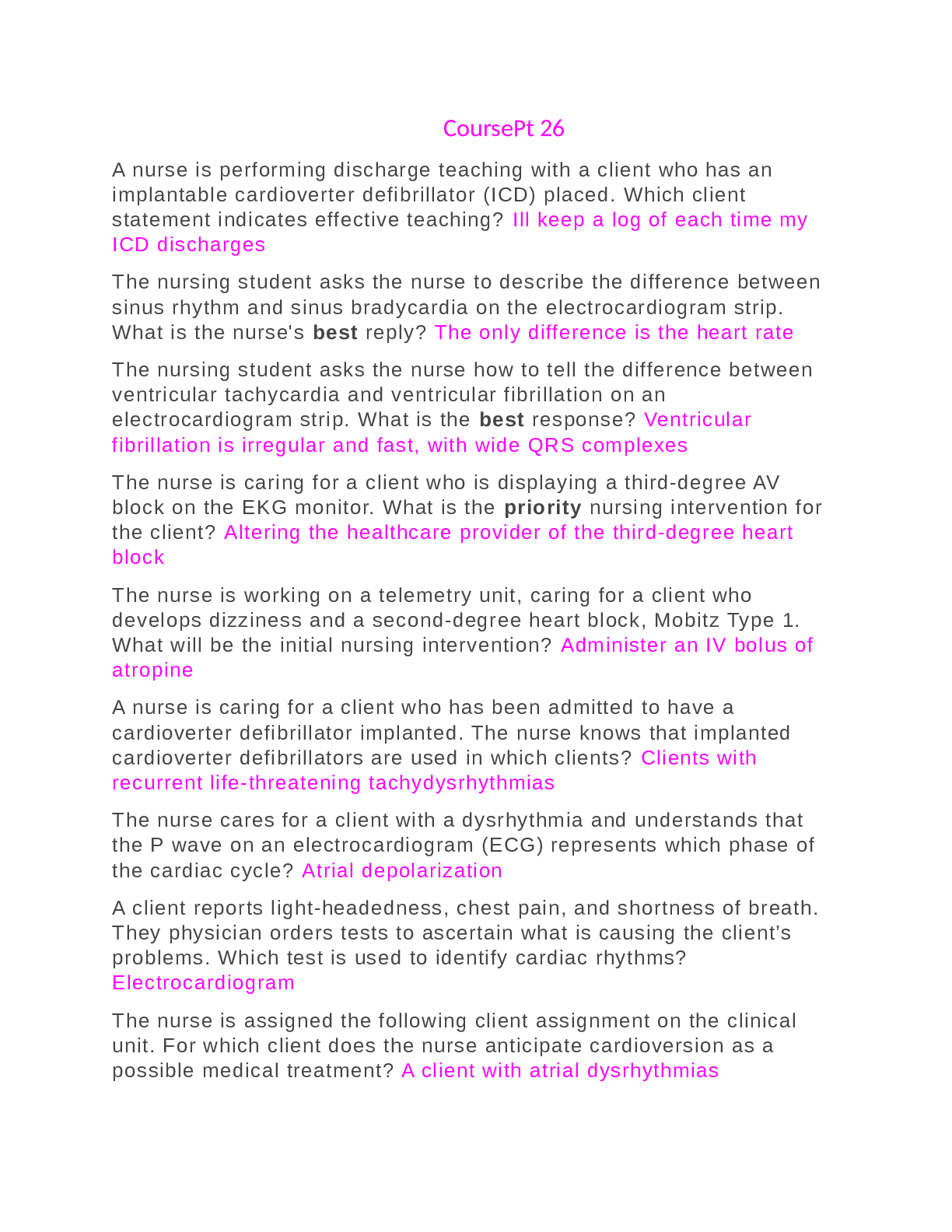
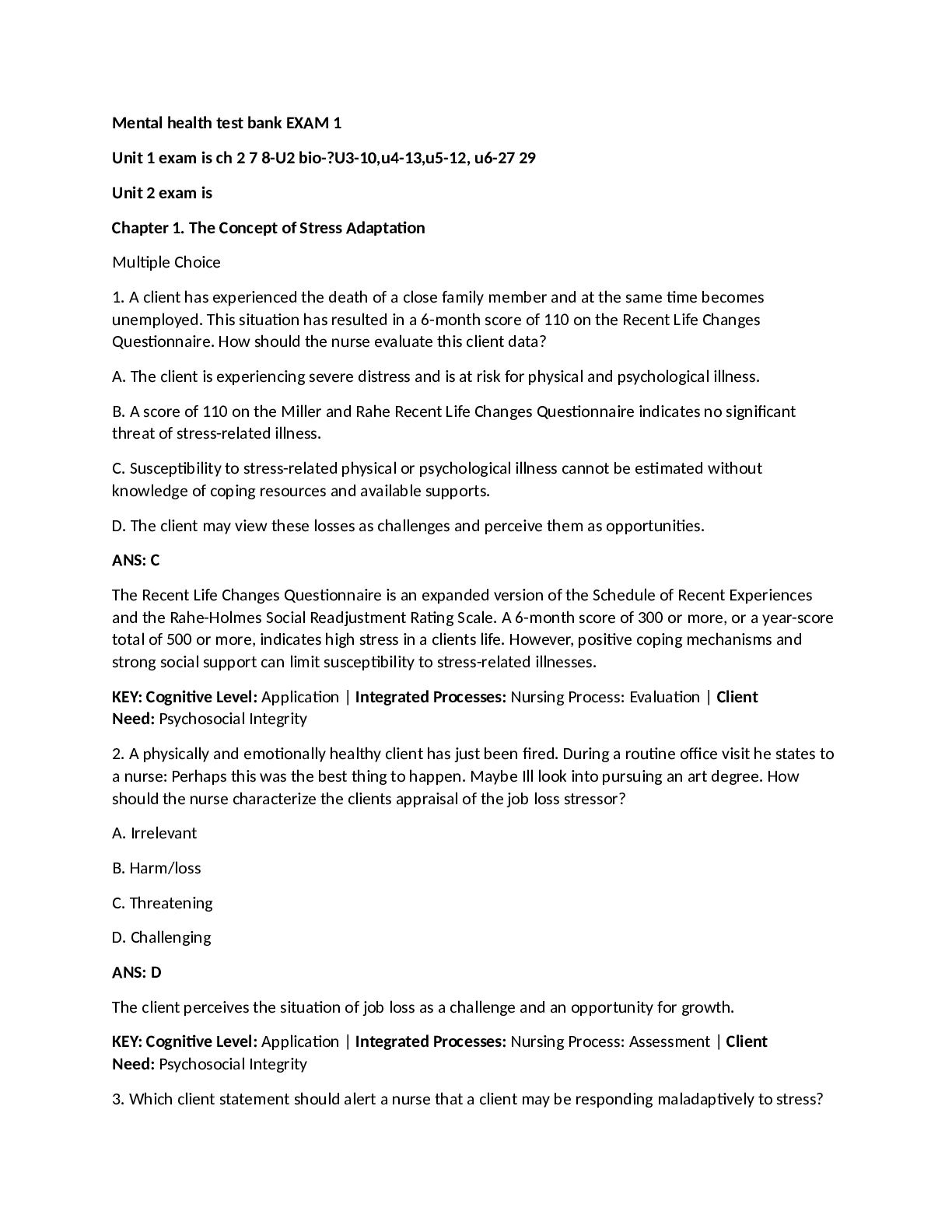
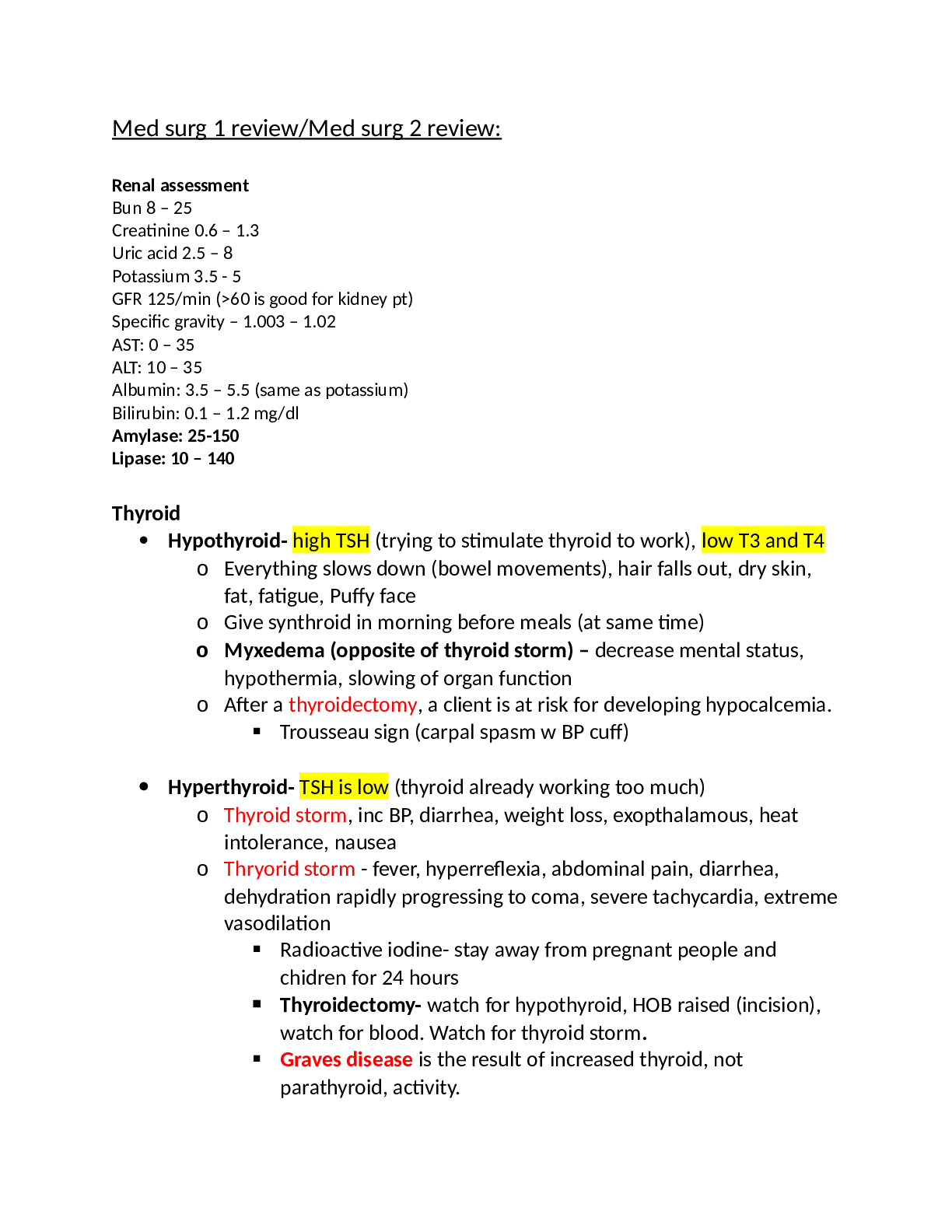

 (1).png)


